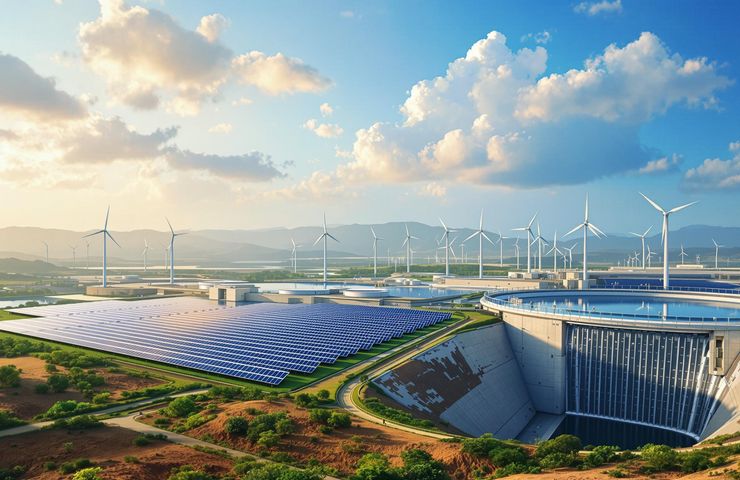
Coal India and AM Green Partner on 4.5GW Clean Energy Project to Power Hydrogen and Ammonia Production
May 12, 2025India’s biggest coal producer is stepping into the future—and it’s a bold leap. In a major pivot from its fossil-fuel roots, Coal India Limited (CIL) is teaming up with clean energy upstart AM Green to build a massive 4.5GW hybrid renewable energy complex. The goal? Power the next generation of green hydrogen and ammonia production—and shake up global energy markets in the process.
A Renewable Powerhouse in the Making
Here’s the plan: They’re combining 2.5 to 3GW of solar PV with up to 2GW of wind energy, all backed by advanced pumped hydro storage. This setup will churn out clean electricity around the clock, fueling electrolysis units at AM Green’s upcoming facilities. Those units will split water into green hydrogen and oxygen—laying the foundation for large-scale ammonia production for both Indian needs and export markets.
Details are still emerging, but locations like sun-soaked Rajasthan and Gujarat are strong bets for solar capacity, while the coastal winds of Tamil Nadu are in play for wind generation. The rollout begins in 2024 and will unfold in phases through 2030.
Sun, Wind, and Water: Fueling Round-the-Clock Hydrogen
At the heart of this project is pumped hydro storage—a tried-and-tested way to store renewable energy and deliver it when needed. During peak sun and wind hours, surplus power will pump water uphill. When the sun dips or winds slow, gravity kicks in—water flows back down, spinning turbines and keeping the electrolyzers humming 24/7.
These electrolyzers, whether alkaline or PEM, will run on gigawatt scale, producing high-purity green hydrogen. That hydrogen feeds into a classic Haber-Bosch ammonia synthesis setup, targeting an impressive 1.8 million metric tons of green ammonia each year.
From Black to Green: CIL’s Bold Transformation
This isn’t just technical evolution—it’s a seismic cultural shift for CIL, the world’s largest coal miner. Established back in 1975, the company is responding to both economic realities and environmental urgencies. One driving force? India’s National Green Hydrogen Mission, launched with $2.3 billion in 2023 to push clean fuel front and center.
If all goes as planned, the transition could slash coal use by up to 50 million tonnes of coal equivalent annually. Plus, it’s expected to create opportunities for retraining over 150,000 coal workers, turning what was once a liability into a key workforce for the sustainable energy economy.
India Eyes the Global Hydrogen Game
But this isn’t just about going green at home. India’s eyeing the global prize—becoming a go-to exporter of green ammonia, especially to Japan and Southeast Asia, where import demand is climbing fast. Backed by deep-pocketed investors like Singapore’s GIC and Japan’s ORIX, AM Green is poised to serve as the linchpin connecting Indian hydrogen with Asian markets.
This quietly coordinated move hints at bigger ambitions: building a rock-solid hydrogen infrastructure that not only meets clean energy targets but shields India from volatile LNG import bills. If successful, the effort could knock 12% off those gas expenditures—no small feat.
Big Money, Big Challenges
Of course, ambition comes with a hefty price tag—somewhere around ₹250 billion (that’s close to $2.92 billion). And while financing details are still being nailed down, the physical demands are pretty staggering, too. Producing all that green ammonia will mean sourcing 9 billion liters of demineralized water annually—a serious ask in parts of India already grappling with water stress.
To manage costs and reliability, the companies are weighing a captive power model. That way, they get more control over power supply and pricing—but integrating all this with India’s evolving grid will be no small engineering feat.
Promises and Pressures in the Energy Shift
Let’s not kid ourselves—this kind of transition isn’t going to be all smooth sailing. Projects of this scale need massive amounts of land, which could become a flashpoint with local communities and environmental activists. And while retraining plans are in motion, shifting thousands of coal workers into green jobs won’t happen overnight.
What Makes This Different
This isn’t another feel-good renewable energy press release. It’s the first major coal-to-hydrogen pivot inside a legacy fossil fuel titan—and it could open the floodgates for others to follow. As India targets 500GW of non-fossil capacity by 2030, players like CIL could be the ones who turn vision into velocity.
At the end of the day, Coal India and AM Green aren’t dabbling—they’re betting big. This project could plant India firmly on the global sustainable energy map and signal the start of a new era where coal giants are the unexpected heroes of the clean hydrogen economy.
Keep an eye on this one. If it works, the rest of the fossil fuel world might just start moving a whole lot faster.



 With over 15 years of reporting hydrogen news, we are your premier source for the latest updates and insights in hydrogen and renewable energy.
With over 15 years of reporting hydrogen news, we are your premier source for the latest updates and insights in hydrogen and renewable energy.